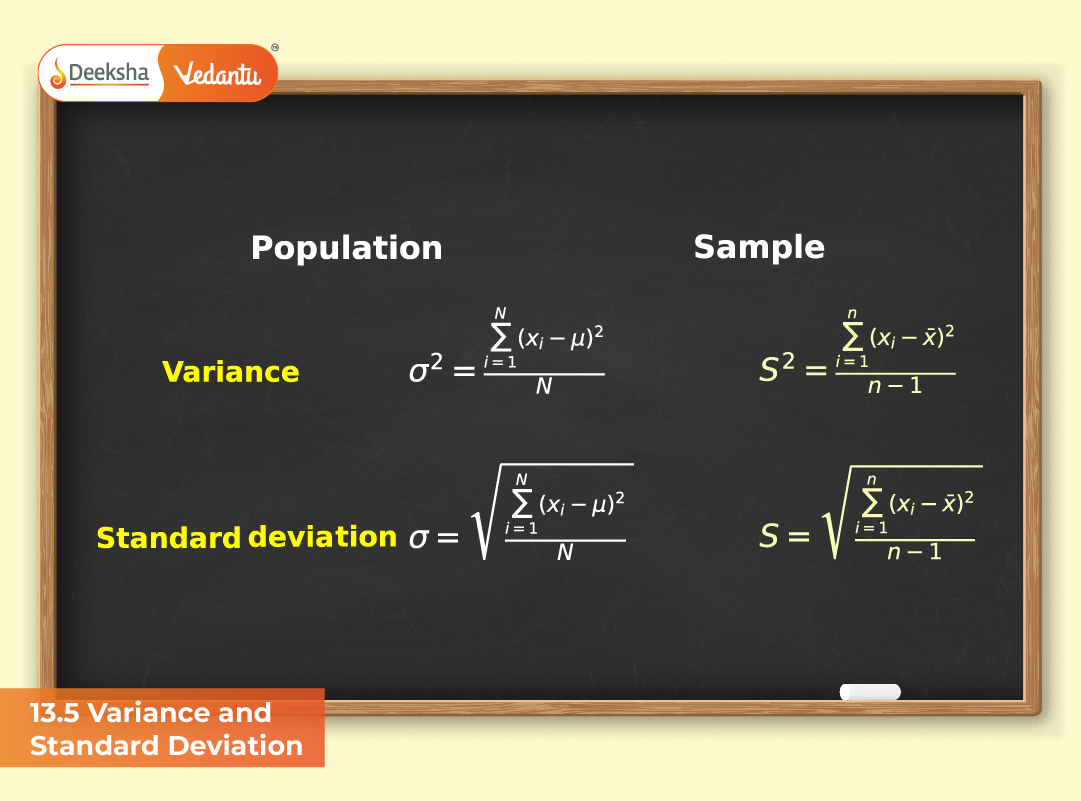
Understanding variance and standard deviation is a cornerstone of statistics. These measures tell us how much the data values deviate or spread out from the mean. In other words, while the mean gives us the central tendency, the standard deviation explains how consistent or variable the data is. For JEE aspirants, mastering this concept is not just about solving textbook problems but about understanding how to handle variability in large datasets, analyze random experiments, and make sense of probability distributions.
Meaning of Variance
Variance is the average of the squares of deviations from the mean. It measures how far each value in a dataset lies from the mean. A higher variance means data points are more spread out; a lower variance means they are closer to the mean.
Formula for variance (σ²):
σ² = (1/n) Σ (xi – x̄)²
Where:
- n = number of observations
- xi = each individual observation
- x̄ = mean of the data
The term (xi – x̄) is called the deviation of each observation from the mean.
Key insight: Squaring the deviations ensures that positive and negative differences don’t cancel each other out. It also gives more weight to larger deviations.
Meaning of Standard Deviation
The standard deviation (σ) is the square root of the variance. It brings the measure of dispersion back into the same unit as the original data, making it easier to interpret.
Formula:
σ = √σ² = √[(1/n) Σ (xi – x̄)²]
For example, if you are calculating the standard deviation of students’ marks in a test (out of 100), the result will also be in “marks,” not marks².
Standard deviation is widely preferred because it is intuitive and comparable across different datasets or experiments.
Why Standard Deviation is Important in JEE
In the JEE Mathematics syllabus, standard deviation and variance are commonly tested under the “Statistics and Probability” unit. Students are expected to:
- Calculate standard deviation for different datasets.
- Apply shortcut methods using assumed mean and step deviation.
- Interpret results and compare consistency between datasets.
Weightage in JEE:
- Statistics (including mean, median, mode, variance, standard deviation): 1–2 questions (typically 4 marks).
- Probability and Statistics combined: around 8–10 marks.
Understanding this topic can help you answer questions efficiently, especially those involving frequency distributions or grouped data.
13.5.1 Standard Deviation for Ungrouped Data
For ungrouped data, each data point is considered individually.
Steps to calculate:
- Find the mean (x̄).
- Subtract the mean from each observation (xi – x̄).
- Square each deviation.
- Find the mean of the squared deviations.
- Take the square root of that mean to get σ.
Formula:
σ = √[(1/n) Σ (xi – x̄)²]
Example:
Find the standard deviation for 2, 4, 6, 8, 10.
Step 1: Mean = (2 + 4 + 6 + 8 + 10) / 5 = 6
Step 2: Deviations (xi – x̄): -4, -2, 0, 2, 4
Step 3: Squares of deviations: 16, 4, 0, 4, 16
Step 4: Variance = (16 + 4 + 0 + 4 + 16) / 5 = 8
Step 5: Standard Deviation = √8 = 2.828
Interpretation:
The data is fairly consistent, as deviations from the mean are small.
Standard Deviation of a Discrete Frequency Distribution
When each observation (xi) has a frequency (fi), meaning some values occur multiple times, the formula changes slightly.
Formula:
σ = √[ (1/N) Σ fi (xi – x̄)² ]
Where N = Σ fi (total frequency).
Alternative (Computational) Formula:
σ² = (Σ fi xi²)/N – [(Σ fi xi)/N]²
This form is often easier to use for large datasets since it avoids recalculating each deviation individually.
Example:
Find σ for the following data:
| xi | 1 | 2 | 3 | 4 | 5 |
| fi | 4 | 6 | 8 | 2 | 0 |
Step 1: Mean (x̄) = (Σ fi xi)/N = (41 + 62 + 83 + 24)/20 = (4 + 12 + 24 + 8)/20 = 48/20 = 2.4
Step 2: Compute (xi – x̄)² and multiply by fi, or use the computational formula:
Σ fi xi² = (41² + 62² + 83² + 24²) = (4 + 24 + 72 + 32) = 132
σ² = (132/20) – (2.4)² = 6.6 – 5.76 = 0.84
σ = √0.84 = 0.916
Standard Deviation of a Continuous Frequency Distribution
In continuous distributions, data is grouped into class intervals. The midpoint of each class (xi) is used to represent that class.
Formula:
σ = √[ (1/N) Σ fi (xi – x̄)² ]
Computational Formula:
σ² = (Σ fi xi²)/N – [(Σ fi xi)/N]²
Example:
| Class Interval | 0–10 | 10–20 | 20–30 | 30–40 | 40–50 |
| Frequency (fi) | 5 | 8 | ₹15 | 16 | 6 |
Step 1: Midpoints (xi): 5, 15, 25, 35, 45
Step 2: N = 5 + 8 + 15 + 16 + 6 = 50
Step 3: Σ fi xi = (55 + 815 + 1525 + 1635 + 645) = 25 + 120 + 375 + 560 + 270 = 1350
Σ fi xi² = (525 + 8225 + 15625 + 161225 + 62025) = 125 + 1800 + 9375 + 19600 + 12150 = 43050
σ² = (43050/50) – (1350/50)² = 861 – 729 = 132
σ = √132 = 11.49
Interpretation:
The spread of data around the mean is moderate, indicating some variability among the classes.
Shortcut Method (Assumed Mean or Step-Deviation Method)
For large datasets, calculations can be simplified using an assumed mean (A) and class width (h).
Let yi = (xi – A)/h
Then,
x̄ = A + h (Σ fi yi / N)
σ² = h² [ (Σ fi yi²)/N – ( (Σ fi yi)/N )² ]
σ = h √[ (Σ fi yi²)/N – ( (Σ fi yi)/N )² ]
Example:
| Class Interval | 0–10 | 10–20 | 20–30 | 30–40 | 40–50 |
| Frequency (fi) | 4 | 6 | 10 | ₹8 | ₹2 |
Assume A = 25, h = 10, midpoints (xi): 5, 15, 25, 35, 45
Then yi = (xi – 25)/10 = -2, -1, 0, 1, 2
| xi | fi | yi | fi yi | fi yi² |
| 5 | 4 | -2 | -8 | 16 |
| 15 | 6 | -1 | -6 | 6 |
| 25 | 10 | 0 | 0 | 0 |
| 35 | 8 | 1 | 8 | 8 |
| 45 | 2 | 2 | 4 | 8 |
Σ fi = 30, Σ fi yi = -2, Σ fi yi² = 38
σ² = 10² [ (38/30) – (-2/30)² ] = 100 [1.266 – 0.004] = 100 * 1.262 = 126.2
σ = √126.2 = 11.23
Real-Life and Advanced Applications
- JEE Probability and Statistics Problems: Variance and standard deviation concepts often appear in random variable questions.
- Experimental Physics: Used in analyzing measurement errors.
- Economics: To study income inequality or inflation variability.
- Data Science and AI: Measures data spread in large datasets.
JEE Advanced Applications
- Conceptual questions may connect variance and standard deviation with probability distributions, such as Binomial or Normal distributions.
- Example: “Find the variance of a binomial distribution with n = 10, p = 0.4.”
Solution: Variance = npq = 10 * 0.4 * 0.6 = 2.4
Sample Problem for Practice
Question: The mean of 20 observations is 50 and their standard deviation is 5. If each observation is multiplied by 2, find the new mean and standard deviation.
Solution:
New mean = 2 × 50 = 100
New standard deviation = 2 × 5 = 10
Concept: Multiplying all observations by a constant ‘k’ multiplies both mean and standard deviation by ‘k’.
FAQs
Q1. What is the main difference between variance and standard deviation?
Variance measures the average squared deviation, while standard deviation measures the average deviation in original units. Standard deviation is more practical because it’s in the same units as the data.
Q2. Why do we square the deviations when calculating variance?
We square deviations to eliminate negative values and to give greater weight to larger deviations, making the measure more sensitive to variability.
Q3. How can I quickly solve JEE questions on standard deviation?
Use the computational or shortcut formulas to avoid repetitive calculations. Practice recognizing when the data is grouped or ungrouped.
Q4. What’s the typical marks weightage of this topic in JEE?
Usually, 1–2 questions (about 4 marks) are asked from the Statistics chapter, with standard deviation being a common subtopic.
Q5. How does variance help in comparing two data sets?
The dataset with smaller variance or standard deviation is more consistent. JEE problems often ask which data set shows higher consistency based on σ values.
Conclusion
Variance and standard deviation are fundamental tools to measure data dispersion. While variance provides the squared spread, standard deviation simplifies interpretation by expressing it in original units. For JEE aspirants, mastering these concepts enhances not just calculation speed but conceptual clarity, especially when applying these formulas to probability and random variable problems. Regular practice, understanding the derivations, and applying shortcut methods help achieve high accuracy in the exam.






Get Social